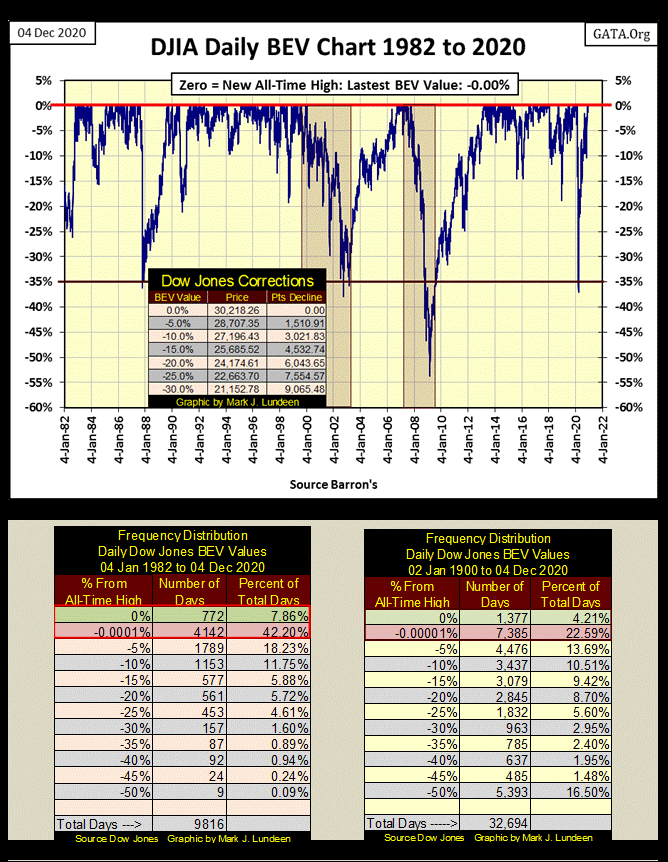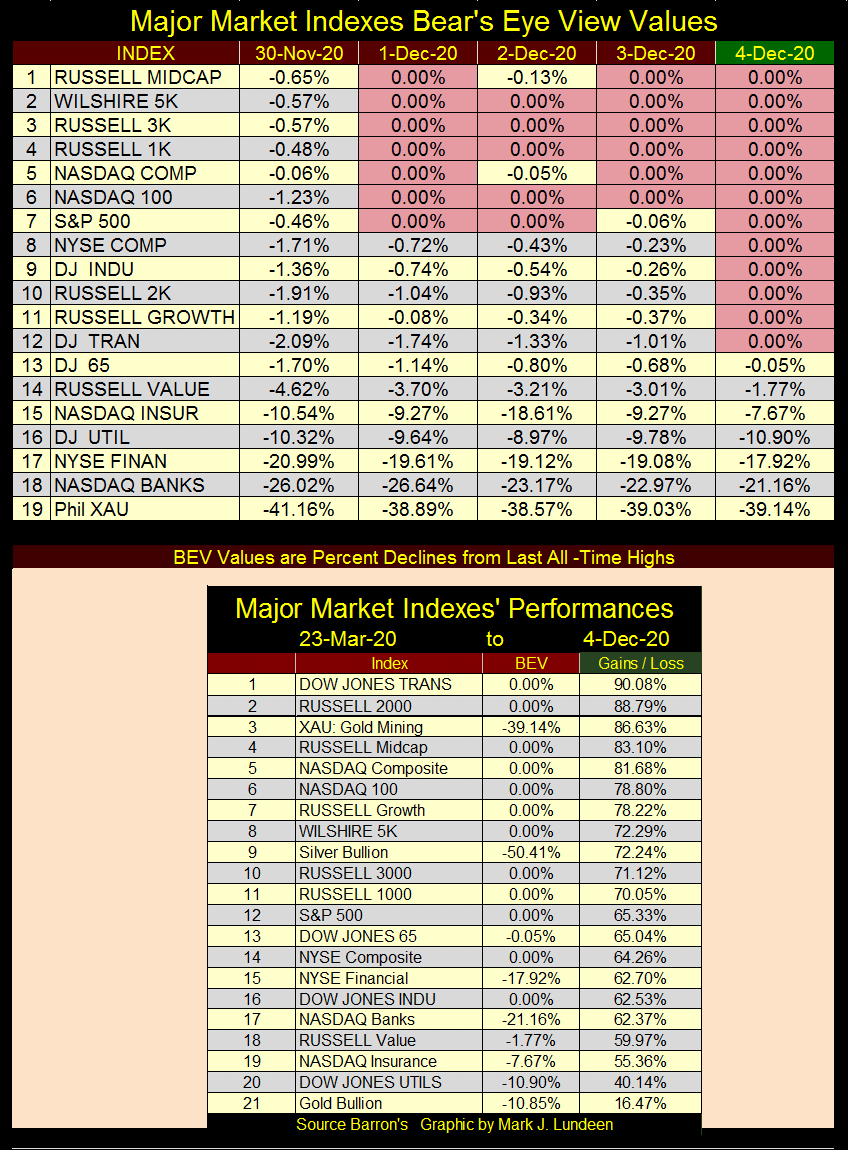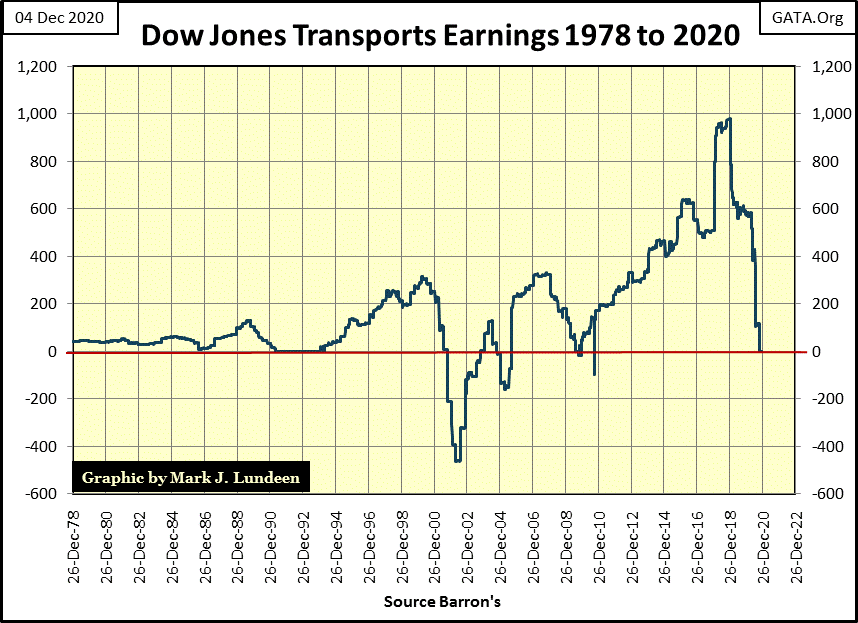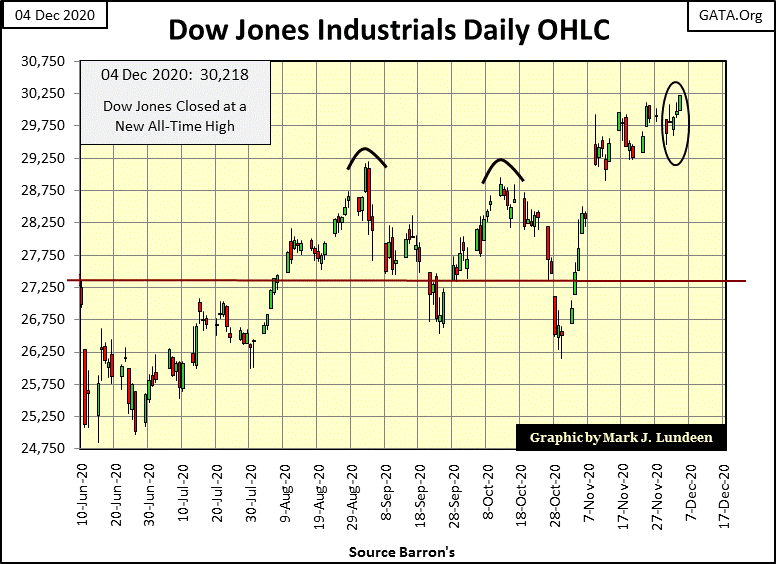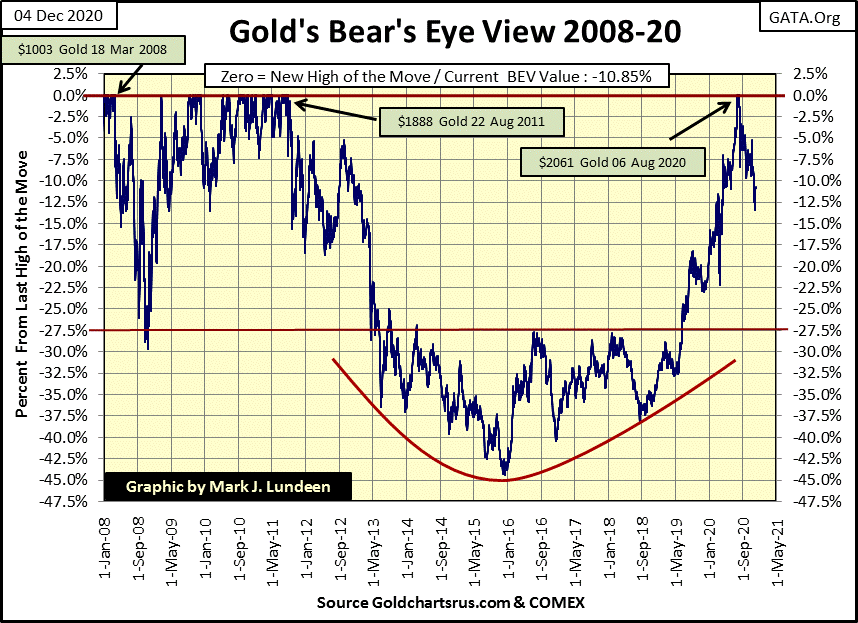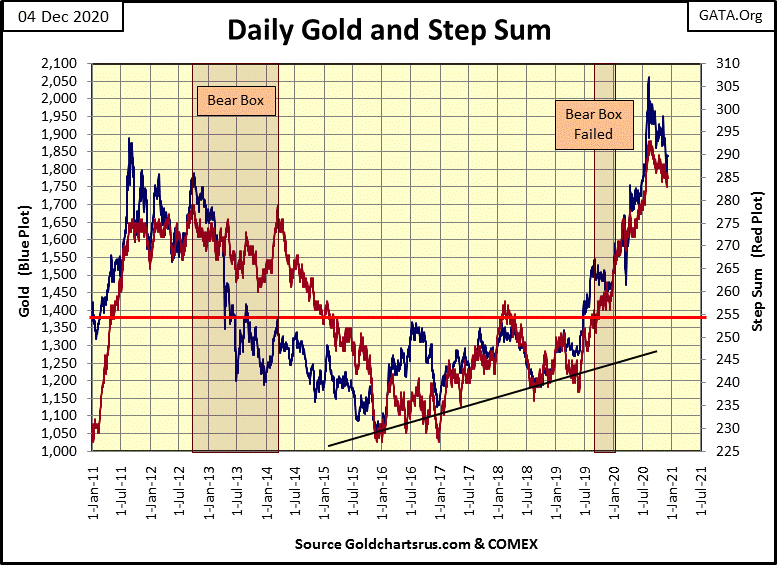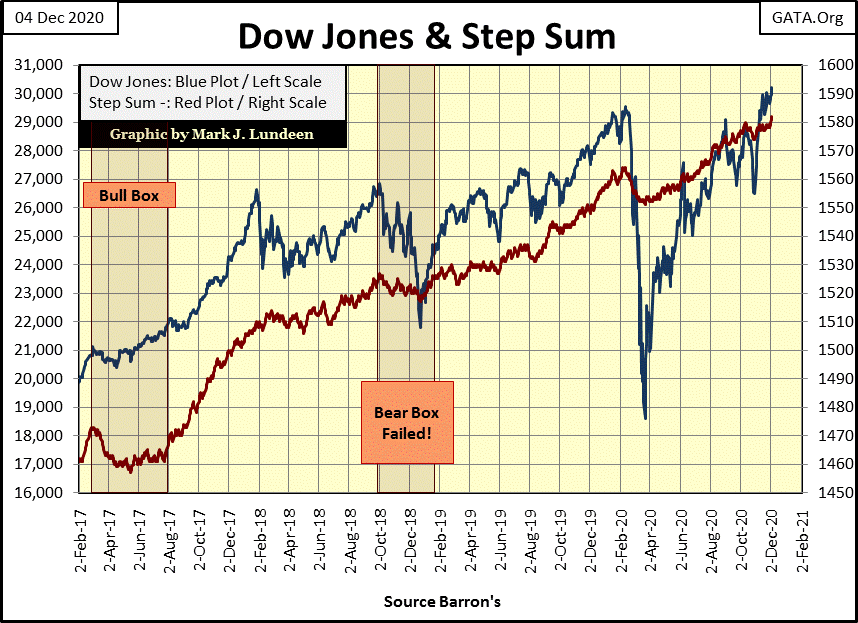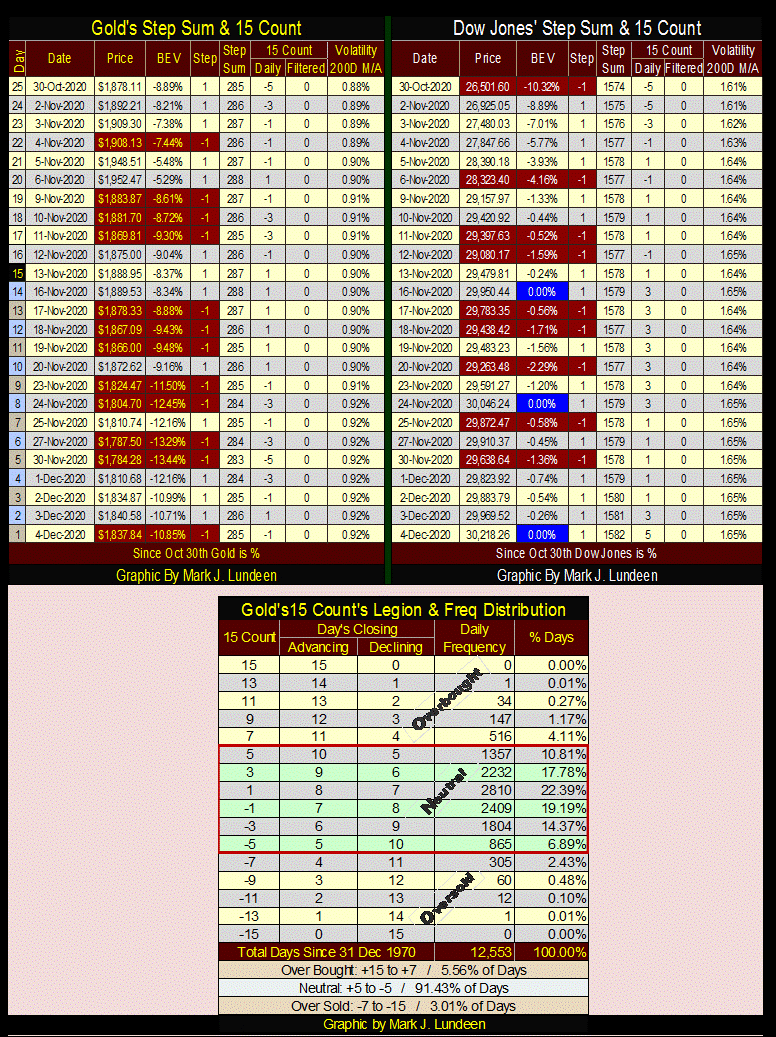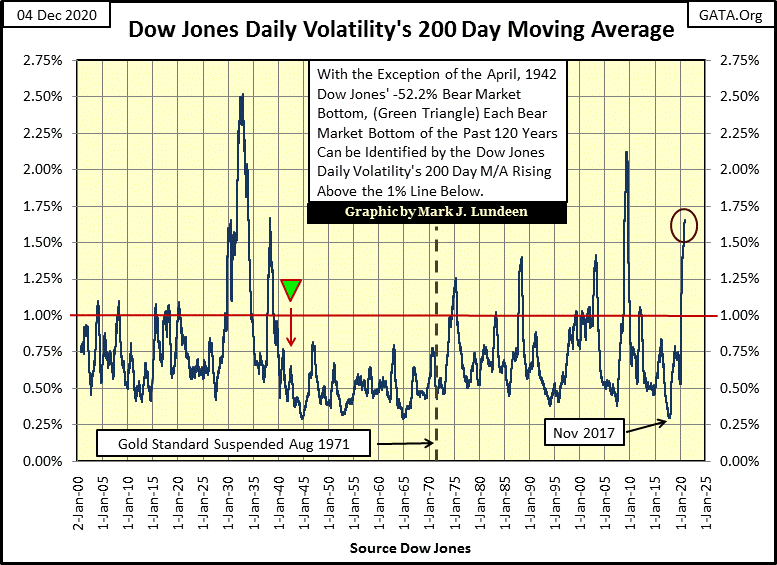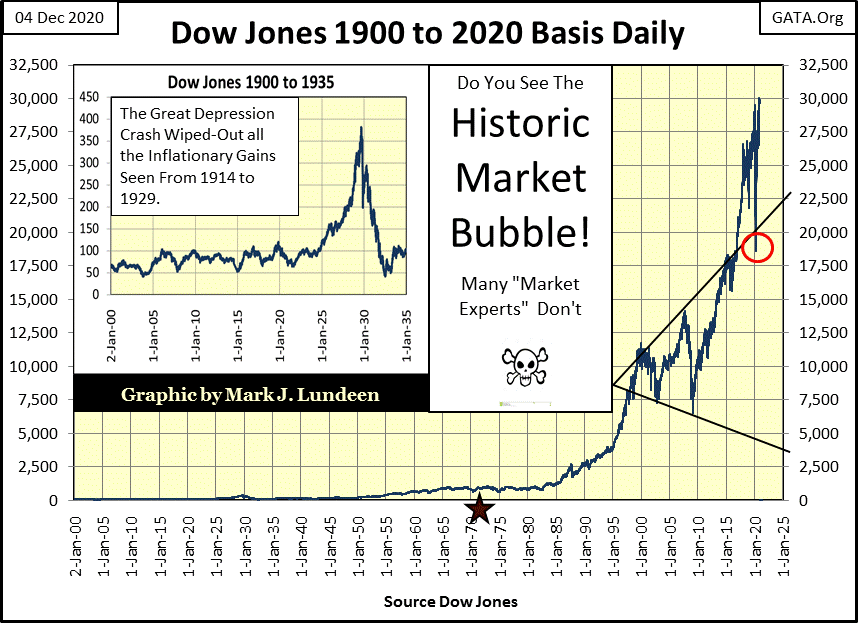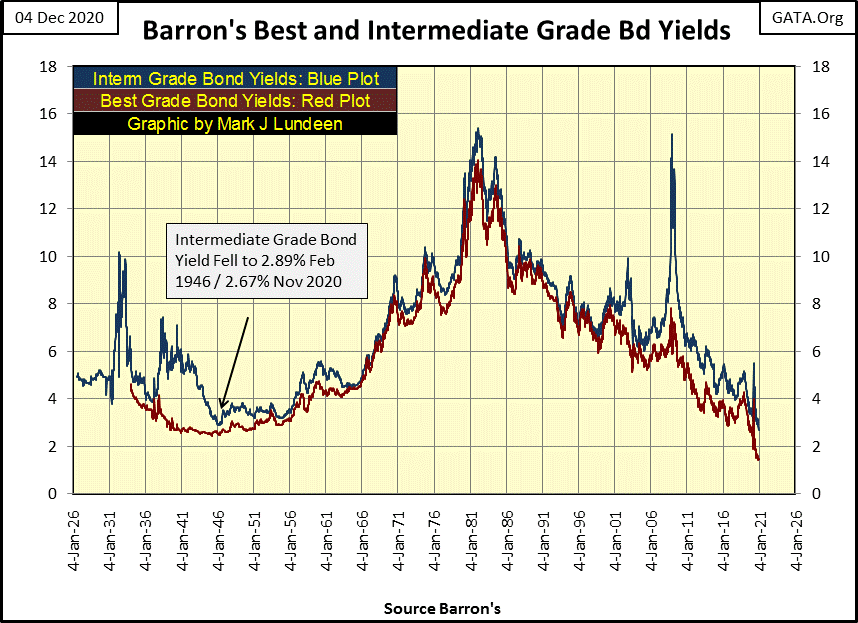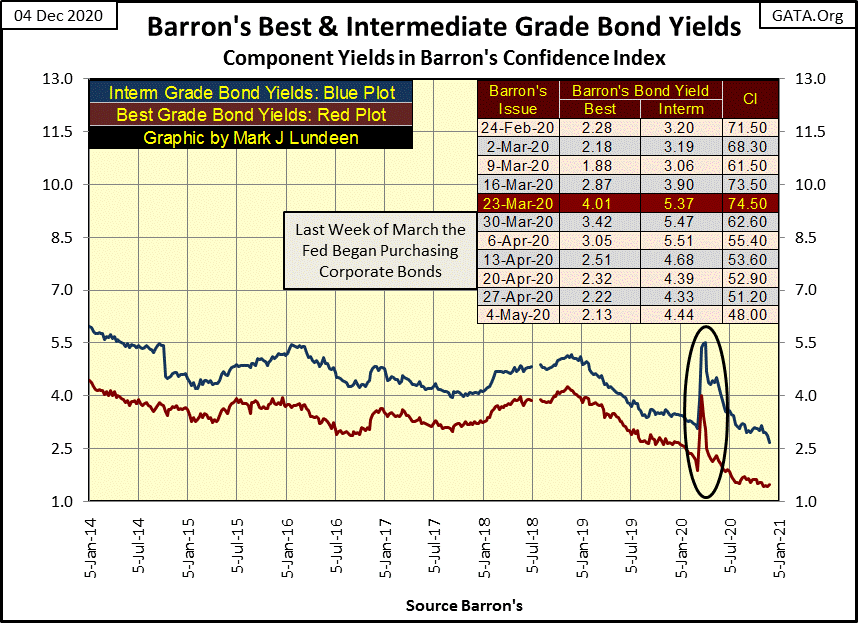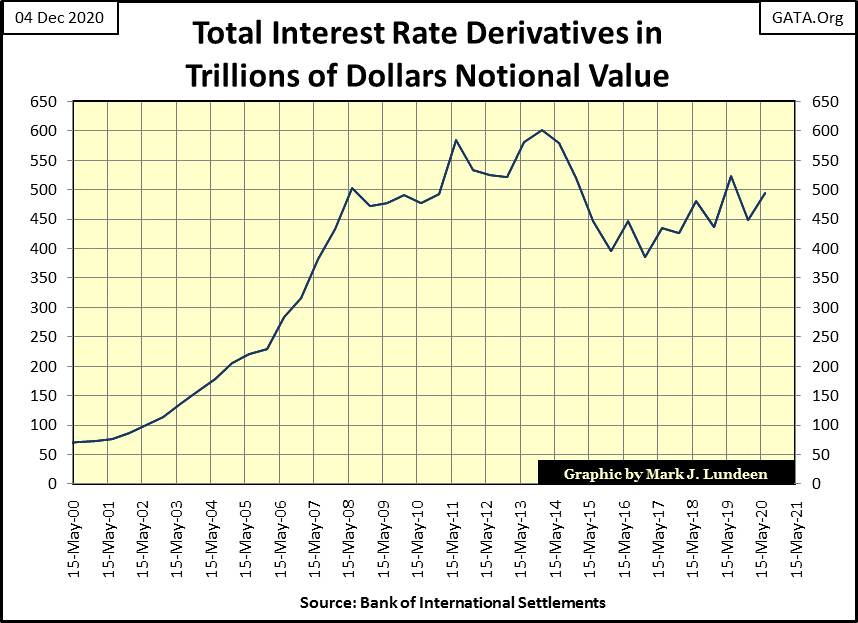Wall Street’s Pending $100-Trillion-Dollar Margin Call
For the 772nd time since January 1982, the Dow Jones closed at a new all-time high, or BEV Zero (0.00%) in its Bear’s Eye View chart below, the third since its 37% correction of last March.
Just looking at the Dow Jones’ BEV chart below, and seeing what it has done following the three previous times it has broken below its -35% BEV line since 1982, we should anticipate a good quantity of new all-time highs in the coming years.
Do I really believe that? Heck no. What the Dow Jones BEV chart below is missing is a bear market bottom that goes deep below its BEV -70% line to correct for all the “liquidity injected” into the stock market since 1982.
However, that is only my opinion, and my opinion isn’t worth much in today’s market. But looking at the Dow Jones for the past forty years as Mr Bear does below; where every new all-time high is equal to a big fat Zero, or BEV Zero (0.00%), and every daily close not a new all-time high is registered as a percentage decline from its last all-time high, for the past four decades that is exactly what has happened: the Dow Jones corrects to something below its BEV -35% line, and then rebounds back to new all-time highs for years to come.
What’s amazing in the BEV chart above is for the past four decades the Dow Jones closed at a new all-time high or within 5% of one for 50.06% of its past 9,816 daily closings (Left Freq Table). Looking at this data from January 1900 to this week’s close (Right Freq Table), the Dow Jones closed at a new all-time high or within 5% of one in only 26.7% of its 32,694 daily closings of the past 121 years. So I see the market advance since 1982 as a huge inflationary bubble that ultimately will be followed by a deflationary bear market decline, similar to if not worse than the Dow Jones saw in the depressing 1930s.
But when? I can clearly see the what, it’s the when part I’m having difficulties with, so I’m not the guy to answer that question.
Here are the BEV values for the major market indexes I follow. Friday saw twelve of them closing at Bev Zeros. For a geriatric bull market, I’m quite impressed. But I’m not ready to sell my gold and silver miners and buy Apple or Amazon just yet or anytime soon.
If you’re looking for advice on when to buy and sell in the broad stock market, you’re just going to have to go somewhere else as I have an iron hand on my tiller, keeping the pending disaster in financial markets to the fantail as I set my course by this market’s setting sun.
But that doesn’t mean there aren’t people making money investing in this market, as I’m sure there are. I’m just assuming the next few decades will be much different from the last four.
As precious metal assets and their miners have had as bad a time as everything else has had it good since 1982, I think it prudent that people sell into the strength of the current market advance and shift their funds into gold, silver and PM miners. And then have the patience to wait for a shift in the market’s paradigm concerning the benefits of central bank interference in the market, as central banking finally destroys the global money supply with unlimited monetary inflation.
What with the Dow Jones Transport Average being at the #1 spot in the table above? Look at its earning in the chart below; in the past two years the Transports’ earning has declined from $1000 down to nothing in October. So much for believing earnings are a leading indicator for price action.
And look at the advances off last March’s 37% market correction! We have the Dow Transports with its zero earnings up 90% in the past nine months and almost everything else up by over 50%. I remember back in the 1970s when financial advice to novices (such as myself) were told to seek a 10% annual gain in the stock market for long-term compound interest gains. People today investing in insurance stocks (#19) are feeling robbed with their puny nine-month advance of only 55%.
Seeing gains such as those above are not normal, nor will they prove to be long lasting. But as long as the FOMC continues “injecting liquidity” into the financial system, who know when this is going to stop?
Looking at the Dow Jones’ in daily bars below, we see the effects of it closing above 30K; I had to increase my Y-Axis up to 30,750.
How far could the Dow Jones advance from here? As it has advanced by 62.53% from its lows of last March, in the spirit of the season let’s be generous and assume it will advance by another 62.53% in the next nine months. That will be a Dow Jones at 49,257 by August.
Could the venerable Dow do that? With a little help from its friends at the FOMC, administering “injections of liquidity” as required – damn right it could. And if it does, no one in the mainstream financial media will find such a move alarming.
Two weeks ago I accepted the possibility that gold, silver and their miners required a bit more time in the penalty box before they could come out and advance into history. On a Saturday night I didn’t think the BEV -10% line would hold, and lucky me I got that right on the following Monday. That doesn’t happen often! But I was expecting gold to break below its BEV -15% line in the chart below, and so far that hasn’t happened.
Gold bottomed on November 30th with a BEV of -13.44% as its 15 count declined to a -5, or in the past fifteen daily closings, gold had seen only five advances. The specifics can be seen in gold’s Step Sum & 15 Count table below, but I have a feeling that with gold’s 15 count of -5 on November 30th as it came just short of breaking below its BEV -15% line, gold has seen a short term bottom at a minimum, and possibly the turning point for it to go on to new all-time highs.
Like me, my readers will just have to wait to see how this plays out; whether gold corrects down as far as to its BEV -20% line in the weeks and months to come, or if it should see a new all-time high early in 2021. Three weeks from Christmas and I’m feeling merry about the prospects for precious metal assets in the year to come.
Gold’s step sum chart below is a source of comfort. These step sum charts compare market reality (Blue Plot / Price of Gold) with market expectations (Red Plot / Market Sentiment).
Look at gold’s step sum plot during 2011, it zoomed upward with the advancing price of gold, as the bulls were sure gold was freeing itself from the oppressive hands of “policy.” But in 2011 this was not to be.
Then came the 2012-2014 bear box, where market sentiment (Red Plot) refused to follow the market reality (Blue Plot) of deflating gold prices, and wouldn’t until May of 2014 when market sentiment (Red Plot) once again recoupled with the market reality of deflating gold prices. At their December 2015 bottoms, market psychology in the gold market was in a depressed state. But that’s what hard bottoms look like, bargain prices that few dare to take advantage of.
For the next few years, gold struggled to break above, and stay above its $1360 line, or BEV -27.5% line in a BEV chart. Then in the summer of 2019 gold made a break out and finally closed above $2000 in August of this year, and for the past four months, gold has been taking a well-deserved rest.
I could be wrong, but I look at this chart and all I see is the potential for gold to do amazing things in 2021.
Market sentiment for the Dow Jones (its red step sum plot below) continues to be positive, and for good reason, has for years. So where do we go from here? See a repeat of the last nine months and have the Dow Jones at 49K by next August? That sounds ridiculous here in December, but how funny will that be next June? These big-bull markets tend to terminate with a blow off stage before Mr. Bear comes and takes it all away.
Below we see gold’s 15 count of -5 on November 30th as it bottomed with a BEV of -13.44%, marking a bottom, or so it appears. Let’s see how this works out in the weeks and months to come.
Looking at the Dow Jones side of this table, daily volatility (200 day M/A) closed the week at 1.65%. Looking at this data for the past 120 years in the chart below, there is something so wrong with that!
And what would that be? Since 1900, every time daily volatility increased above its 1.00% line in the chart below, the Dow Jones was down 40% or more from an all-time high. But in December 2020 we see daily volatility at 1.65% as the Dow Jones has made three all-time highs since mid-November.
Obviously, the idiot savants at the FOMC are working hard “supporting this market’s valuation.”
Corporate Bond yields have declined below levels seen in the mid-1940s in the aftermath of WW2. There is no mystery why that is so; Fed Chairman Powell announced last March the FOMC was going to “support the credit markets” by purchasing corporate bonds.
The Federal Reserve Moves to Buy Corporate Debt
Forbes: Mar 23, 2020,10:56am EDT
“In an unprecedented U.S. action, the Federal Reserve moved on Monday to buy corporate debt, one of several actions the U.S. central bank took in a massive start-of-the-week intervention to support credit markets amid the dramatic economic impact of dealing with the coronavirus.”
This announcement marked the precise, March 23rd turnaround in the swiftest market decline the Dow Jones has seen since 1885; last winter’s 37% market decline in only twenty-eight NYSE trading sessions. Looking at the chart below, had Fed Chairman Powell not “supported the credit markets” last March, I suspect the Dow Jones would not have broken above 30K in late November, but today find itself far below the lows of last March (Red Circle below).
Being no “market expert” myself; I doubt this action was in response to the CCP virus. My readers will have to excuse me if I believed this action by the FOMC prevented massive debt defaults in corporate America, which last March’s 37% market collapse in the Dow Jones was anticipating.
And then last June:
Powell says the Fed doesn’t want to ‘run through the bond market like an elephant’
CNBC: JUN 16 202010:52 AM EDTUPDATED TUE, JUN 16 202012:41 PM ED
“In a move first telegraphed on March 23, the Fed said it will expand its purchase of corporate bonds beyond exchange-traded funds and into individual issues. The result will be essentially creating its own index of bonds that spread across a wide swatch of the market and could see the Fed ultimately purchase up to $750 billion worth of securities.”
“Run through the bond market like an elephant?” A very odd choice of words coming from a “policy maker.” Similar to flying at 35,000 feet and hearing the plane’s captain say on the PA he doesn’t want to fly into a mountain like an idiot.
Here’s a chart plotting weekly data for Barron’s Best and Intermediate Grade Bond yields going back to the 1920s. Best-grade bond yields declined to historic levels last spring, and in Barron’s last issue for November 2020, yields for intermediate-grade bonds broke below their last all-time lows of February 1946, as noted in the chart below.
Here’s a shorter term chart of these two bond yield series. Note March 23rd also marked a spike in bond yields (a crash in bond valuations). Last March most “market experts” commentated on how the FOMC action of “supporting the credit markets” benefitted the distressed stock market. But if the corporate-bond market wasn’t also crashing, would the FOMC have begun buying corporate bonds? I think not.
Decades ago the big topic “market experts” discussed was OTC derivatives. The US Senate had a big public hearing on them in 1999 which was covered in full by CNBC, when then Secretary of Treasury, Robert Rubin and Fed Chairman, Alan Greenspan endorsed in glowing terms.
Apparently these marvelous financial instruments would “stabilize the financial markets by distributing market risk to those best able to bear them.” Who could be against that? They posed no risks to the public as they traded in a “private market” operated by professional money managers. Hence the OTC derivative market had no need to be regulated by the Federal Government, not with J.P. Morgan and Goldman Sachs providing leadership in this “private market.” And with these derivatives stabilizing the financial markets, the US Government could finally overturn the depression era Glass Steagall Banking Act.
This act forced Wall Street to act in a responsible manner by splitting up the banking system, in effect placing a firewall between commercial and investment banking. Banks had to commit whether their daily operations were focused on stocks and bonds, in which case the bank was classified as an investment bank and could no longer accept savings deposits from the public.
If banks chose to take savings deposits from the public, they were classified as a commercial bank. The Glass Steagall Act allowed commercial banks to use the public’s savings only for commercial loans (prohibiting the use of the public’s savings in stock market speculations) and to function as a clearing house for settling payments between buyers and sellers in the economy.
The next time CNBC televised in full a public hearing at the US Senate was only nine years later in October 2008, when we all discovered who was best able to bear Wall Street’s market risks in the OTC derivative market: the US Treasury and Federal Reserve. And with the Glass Steagall Banking Act’s firewall removed from the banking system, the global banking system, and its payment system, was on the verge of collapse.
That was twelve years ago, and since then, these OTC derivatives haven’t gone away. In fact going to the BIS link below, they now have notional value for total (global) interest-rate derivatives as of last June at $495 trillion.
https://stats.bis.org/statx/srs/table/d7
That’s a lot when considering SIFMA’s fact book reports global bond market capitalization of only $105.9 trillion as of 2019. So for every $1.00 of bond market, we have $4.66 notional dollars of derivative hedging it.
https://www.sifma.org/resources/research/fact-book/
No doubt financial institutions, such as pension funds and insurance companies are hedging their bond market risks. But apparently, most of these derivatives are being used by people who have no interest-rate risks, but wish to place off-track bets on interest rates.
Here’s a six minute clip from the movie The Big Short that will explain the role derivatives (structured finance) played in the 2007-09 sub-prime mortgage debacle that almost took the world down with them.
https://www.youtube.com/watch?v=A25EUhZGBws&list=PL_eGtR10uhM1yz78V7Ag589_qDMP19s9t&index=16
$495 trillion dollars in notional value for interest rate derivatives; what does that mean? To better understand the scope of “hundreds-of-trillions” it’s best to look at them in terms of astronomy. Our solar system exists within the Virgo Super Cluster of galaxies. As seen in the link below, the Virgo Super Cluster is a vast array of galaxies spanning 100-million light years of space, containing only 200 trillion stars. This is less than half the notional dollars comprising the $495 trillion in interest-rate derivatives.
http://www.atlasoftheuniverse.com/virgo.html
This is a mind boggling large number. How can such a huge market function with little apparent impact on the rest of the economy? To see how, let’s look at one Chicago Board of Trade (CBOT) corn contract in the table below.
This futures contract is a derivative, and by definition a derivate is a financial contract whose value is derived from an underlying asset; in this case 5000 bushels of corn. This CBOT corn contract is not an OTC derivative as the corn market in Chicago is opened to the public, and every contract is a standardized contract of 5000 bushels of clean corn of a certain moisture content.
This corn contract has two parties to it; the seller (short side) who promises to deliver 5000 bushels of corn sometime in the future, and the buyer (long side) who promises to take delivery of 5000 bushels of corn sometime in the future.
The corn market has natural shorts and longs. Farmers are expected to deliver corn to the market, as corporate entities such as General Mills or Cargill are expected to take delivery of corn. The CBOT futures corn market allows both farmers and food processors to manage market volatility in the corn market by offsetting these risks to speculators, city slickers like you and me should we try our luck trading corn contracts at the CBOT.
But trading corn contracts is not the purpose of this article, but used as an illustration for “notional value.”
In the table below at step #1, at the creation of this contract for 5000 bushels of corn, corn was trading at $3.75 a bushel. That times 5000 bushels of corn and this contract created $18,750 in notional value in the corn market, even though the farmer won’t have the corn, or food processor take delivery of the corn for another six months.
And how much money has the farmer or food processor committed to this contract at step #1? Quite possibly nothing, and until the market price of corn changes there is no flow of funds from one party to another in this contract.
There is a negative feedback loop in this contract that stabilizes the corn market. The farmer wants as high of price for his corn as he can get, but the very act of selling his corn depresses the price of corn in the market. The food processor wants corn at the lowest price possible, but the very act of buying corn increases the price of corn in the market.
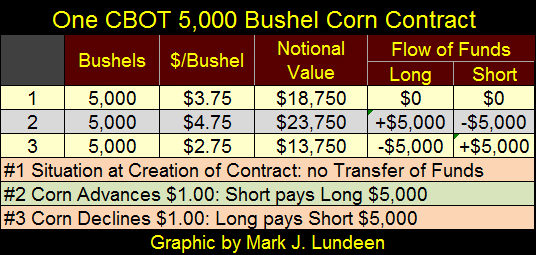
Let’s look at the risk profiles for the long and short side of this contract. Potential losses on the long side are limited. Should corn go from $3.75 down to $0.00, the long can only lose $18,750 on these 5000 bushels of corn, as the potential gains for the short side of this contract are also limited to $18,750 should the price of corn collapse down to zero.
But should corn prices rise, market risks for the short side of this contract are unlimited. Hypothetically, should corn prices rise to $100 a bushel the short side will be obligated to pay $500,000 to the long side of this contract.
So, what I want my readers to understand is:
- Short side profits from lower prices, and has unlimited market risks should market prices rise.
- Long side profits from higher prices; and has limited market risks should market prices decline.
Now let’s return to the OTC interest rate derivatives market where interest rates, not corn are being hedged. I note something odd about hedging interest rates. While everyone benefits from lower bond yields, both the owners of a bond and its issuers, who is it that* naturally * benefits from rising interest rates and bond yields?
For instance, farmers naturally benefit from higher corn prices, food processors naturally benefit from lower corn prices, so who benefits from rising bond yields? To my knowledge no one, and should there be, are they sufficient in number to take the other side of $495 trillion dollars in these OTC derivative contacts? Remember it take two parties to form one of these derivative contracts.
It’s like Popeye once said “I may not be a physicist, but I know what matters.”
And what matters with these interest-rate derivatives is who is taking the other side of these contracts pension fund and insurance companies are hedging their risks of rising bond yields. I’ll give you a hint who I think is; the same banks who in 1999 urged the US Senate to allow them to create this market as a self-regulated operation. Ya, all the usual suspects that had to be bailed out with trillions of dollars by that same US Senate in 2008 & 09.
And why did Fed Chairman Powell last March begin “stabilizing the credit markets” by buying corporate bonds? And last summer felt the need to assure everyone that the FOMC isn’t going to run around in the bond market like an elephant? Maybe for fear of an instantaneous hundred-trillion dollar margin call on his banking system should corporate bond yields rise above a critical threshold that wasn’t far above the yield spikes seen last March in my charts.
We are living in interesting times! Gold and silver bullion with zero counter-party risks have never looked better than they do today.
Mark J. Lundeen
********






